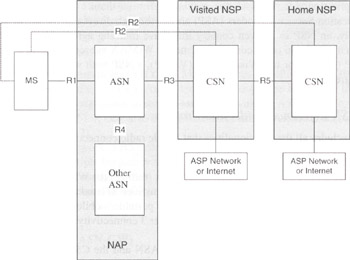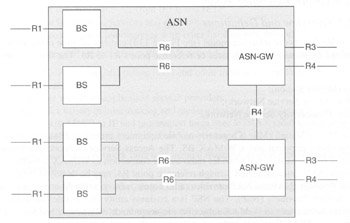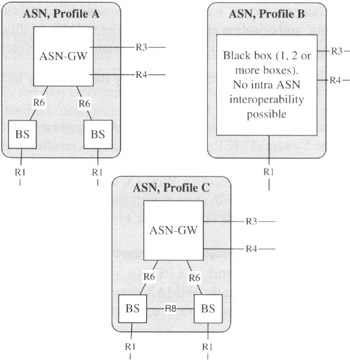13.2 Network Reference Model
13.2 Network Reference Model
13.2.1 Overview and Definitions
The WiMAX network reference model (see Figure 13.1) consists of three components interconnected by standardised interfaces or reference points R1 to R5. The three components are:
-
MS (Mobile Station);
-
ASN (Access Service Network);
-
CSN (Connectivity Service Network).

Figure 13.1: WiMAX network reference model with components (MS/ASN/CSN), reference points (R 1 to R5) and actors (NAP/NSP/ASP) [10]
The Mobile Station (MS) is a generic mobile equipment providing connectivity between a subscriber equipment and a WiMAX BS. The Access Service Network (ASN) includes the set of functionalities that provides radio access connection to WiMAX subscribers. One or several ASN, interconnected through reference point R4, may be deployed by a Network Access Provider (NAP). A NAP provides radio access infrastructure to one or several Network Service Providers (NSP). The NSP is a business entity that enables IP connectivity and WiMAX services to WiMAX subscribers in accordance with established Service Level Agreements (SLA). The NSP deploys the Connectivity Service Network (CSN), which provides the IP connectivity for WiMAX subscribers. On the radio access network side, the WiMAX services are provided through contractual agreements with one or several NAPs.
On the application side, WiMAX services are delivered thanks to contractual agreements with Application Service Providers (ASP) and/or through direct connection to the Internet. Additionally, an NSP in a given country may have roaming agreements with many other NSPs, which may be in other countries. Hence, a WiMAX subscriber may be attached to a Home NSP (H-NSP) or to a Visited NSP (V-NSP), a NSP with whom its home NSP has a roaming agreement.
13.2.2 ASN Reference Model and Profiles
The ASN includes all the functionalities that enable radio connectivity to WiMAX subscribers. As a consequence, the ASN mainly provides:
-
Layer 2 connectivity to the WiMAX subscribers (through the WiMAX air interface);
-
Radio Resource Management (RRM) mechanisms such as handover control and execution:
-
paging and location management (in the case of portable/mobile services);
-
relay functions to the CSN for establishing Layer 3 connectivity with WiMAX subscribers (e.g. IP address allocation, AAA procedures);
-
tunnelling of data and signalling between the ASN and the CSN though reference point R3;
-
network discovery and selection of the preferred NAP/NSP.
The ASN usually consists of several base stations (BS) connected to several ASN gateways (ASN-GW), as depicted in Figure 13.2. Inside the ASN, two additional reference points are described in WiMAX architecture specification Release 1, but only in an informative manner: R6 between BS and ASN-GW and R8 between different BSs [21]. Those interfaces should be the basis for further interoperability points between BS and ASN-GW of WiMAX vendors in subsequent architecture releases.

Figure 13.2: Generic ASN reference model. R3 is between the ASN and CSN while the external R4 is between ASNs
13.2.2.1 Base Station (BS)
The BS is the entity that implements PHY and MAC features as defined in the IEEE 802.16 standards. As defined by the WiMAX Forum technical groups, the BS is also in charge of the scheduling of user and signalling messages exchanged with the ASN-GW through the R6 interface (see below for R6). It may also incorporate other access functions according to the ASN profile (see Table 13.2).
In a WiMAX access network, a BS instance is defined by a sector and a frequency assignment. In the case of a multiple frequency assignment in a sector, the sector includes as many BS instances as frequency assigned. This is similar to 3GPP UMTS or 3GPP2 networks.
The connectivity to multiple ASN-GW may be required in the case of load balancing or for redundancy purposes.
13.2.2.2 ASN Gateway (ASN-GW)
The ASN-GW is a logical entity that includes:
-
control function entities paired with a corresponding function in the ASN (e.g. in a BS instance), a resident function in the CSN or a function in another ASN;
-
bearer plane routing or a bridging function.
The ASN-GW acts as a decision point for nonbearer plane functions (example: radio resource management) and as an enforcement point for bearer plane functions. For implementation purposes, decomposition of ASN functions into these two groups is optional. If this decomposition is done, the two groups are separated by reference point R7. As in any telecom system, the ASN-GW may be designed to provide redundancy and load balancing between different ASN-GW boxes.
13.2.2.3 ASN Profiles
There are three choices for ASN implementations: ASN profiles A, B and C (see Figure 13.3). According to the profiles, some functionalities are implemented by the BS or the ASN-GW (profiles A and C, see Table 13.2) or by any box in the case of a profile B ASN. In particular, profile A implementation includes:
-
handover control inside the ASN-GW, which permits easier control of the radio resources during the handover procedure and preparation of the Layer 3 path re-route;
-
Radio Resource Control (RRC) inside the ASN-GW (load balancing is possible between BSs).

Figure 13.3: The ASN profiles A, B and C
| Function category | Function | Exposed protocols, primitives | Associated reference point | Profile A, ASN entities | Profile C, ASN enttiies |
|---|---|---|---|---|---|
| Security | Authenticator | Authentication relay primitives | R6 | ASN-GW | ASN-GW |
| Authenticator relay | Authentication relay primitives | R6 | BS | BS | |
| Key distributor | AK[a] transfer primitives SA-TEK[b] handshake primitives | R6 | ASN-GW | ASN-GW | |
| Key receiver | AK[a] transfer primitives SA-TEK[b] handshake primitives | R6 | BS | BS | |
| Intra-ASN mobility | Data path function (type 1 or 2) | Data path control primitives | R6 | ASN-GW and BS | ASN-GW and BS |
| Handover functions | Handover control primitives | R6 | ASN-GW and BS | ASN-GW and BS | |
| Context server and client | R6 | ASN-GW and BS | ASN-GW and BS | ||
| Layer 3 mobility | MIP FA[c] | Client MIP | R6 | ASN-GW | |
| Radio resource management | RRC[d] | RRM primitives | R6 | ASN-GW | BS |
| RR[e] | RRM primitives | R6 | BS | BS | |
| Paging | Paging agent | Paging and Idle mode primitives | R6 | BS | BS |
| Paging controller | Paging and Idle mode primitives | R6 | ASN-GW | ASN-GW | |
| QoS | SFA[f] | QoS primitives | R6 | ASN-GW | ASN-GW |
| SFM[g] | BS | BS | |||
|
[a]AK = Authentication Key (transferred during initial network entry).
[b]SA-TEK = Security Association-Traffic Encryption Key (during a three-way handshake procedure between the MS and BS at initial network entry).
[c]MIP FA = Mobile IP Foreign Agent (used for inter-ASN-GW mobility).
[d]RRC = Radio Resource Controller (entity that takes decisions on modifications of radio resources based on radio measurements, or any other information).
[e]RRA = Radio Resource Agent (entity located in a BS that maintains a database of radio resource indicators).
[f]SFA = Service Flow Authorisation (see the QoS section).
[g]SFM = Service Flow Management (see the QoS section). | |||||
ASN anchored mobility points among BSs are achieved through R4 and R6 reference points. This mobility refers to handovers where the anchor point for the MS in the ASN does not change (see Chapter 14 for handovers in the IEEE 802.16 standard).
Profile C implementation has the same structure as profile A, with the major difference being that BSs have much more functionalities. A profile C implementation includes:
-
handover control inside the BS;
-
Radio Resource Control (RRC) inside the BS;
-
ASN anchored mobility points among the BS achieved through R4 and R6 reference points as in profile A.
Profile B does not specify any functional split. The split of functions between boxes. if any, is left to vendor choice. As a consequence, no intra-ASN interoperability is possible with profile B.
13.2.3 CSN Reference Model
The Connectivity Service Network (CSN) consists of all the functions/equipment that enable IP connectivity to WiMAX subscribers. As a consequence, the CSN includes the following functions:
-
user connection authorisation and Layer 3 access (IP address allocation for user sessions, AAA proxy server and functions);
-
QoS management (policy and admission control based on user profiles);
-
mobility support based on Mobile IP (HA (Home Agent), function for inter-ASN mobility);
-
tunnelling (based on IP protocols) with other equipment/networks (ASN-CSN tunnelling support, inter-CSN tunnelling for roaming);
-
WiMAX subscriber billing;
-
WiMAX services (Internet access, location-based services, connectivity for peer-to-peer services, provisioning, authorisation and/or connectivity to IMS, facilities for lawful intercept services such as CALEA (Communications Assistance Law Enforcement Act).
To accomplish those functions, the CSN, deployed by the NSP, may include the following equipment:
-
routers (with eventually an HA function for the inter-ASN gateway mobility);
-
DNS (Domain Name System)/DHCP servers for IP address resolution and user IP address configurations;
-
AAA proxy/servers and user database for WiMAX user access authentication/authorisation/accounting and provisioning, with some reports mentioning the use of a (central) Home Location Register (HLR) as in some other cellular systems (e.g. GSM, UMTS) in order to implement AAA functions;
-
interworking gateways for integration/interoperability of a WiMAX network with another network (e.g. a 3GPP wireless network or a PSTN);
-
firewalls for providing protection to the WiMAX network equipments by enforcing access and filter policies on the traffic to and from an external network (especially used for denial of services detection/prevention).
13.2.4 Reference Points
The WiMAX network reference model defines several reference points (RPs) between several entities in the WiMAX network (see Figures 13.1 and 13.3). Those RPs introduce interoperability points between equipments from different vendors. In the scope of the Release 1 WiMAX network architecture, there are six mandatory RPs (R1 to R6) and two informative RPs (R7 and R8).
13.2.4.1 Reference Point R1 (Normative)
Reference point R1 refers to the radio interface between the MS and the ASN. It consequently includes all the physical and MAC features retained in WiMAX profiles from the IEEE 802.16 standard. R1 carries both user traffic and user control plane messages.
13.2.4.2 Reference Point R2 (Normative)
Reference point R2 is a logical interface between the MS and the CSN. It contains all the protocols and other procedures that are involved with authentication (user and device), service authorisation and IP host configuration management. This logical interface is established between the MS and the H-NSP and some protocols (such as the IP host address management) may be performed by the visited NSP in the case of roaming.
13.2.4.3 Reference Point R3 (Normative)
Reference point R3 is the logical interface between the ASN and the CSN. It conveys both control plane messages, (AAA methods, policy enforcement methods for end-to-end QoS, mobility management messages e.g. for MS relocation) and data plane information through tunnelling between the ASN and the CSN.
13.2.4.4 Reference Point R4 (Normative)
Reference point R4 interconnects two ASNs (ASN profile B) or two ASN-GWs (ASN profiles A or C). It conveys both control and data plane messages, especially during the handover of a WiMAX user between ASNs/ASN-GWs or during location update procedures in the Idle mode. This RP is presently the only interoperable point between ASNs from different vendors.
The tunnelling method recommended is to use IP in IP tunnelling mode for R4 based on the GRE (Generic Routing Encapsulation) protocol [35].
13.2.4.5 Reference Point R5 (Normative)
Reference point R5 is the interface interconnecting two CSNs. It consists of the set of control and data plane methods between the CSN in the visited NSP and in the home NSP.
13.2.4.6 Reference Point R6 (Normative for Profiles A and C)
Reference point R6 is normative in WiMAX architecture Release 1 in the context of specific ASN profiles. In Release 1, ASN profiles A and C decompose the ASN into BS and ASN GW. In each case, normative procedures over R6 are specified in Release 1. R6, of course, is not applicable to profile B.
Reference point R6 connects the BS and the ASN-GW. It conveys both control messages (for data path establishment, modification, control, release in accordance with MS mobility) and data plane (intra-ASN data path between BS and ASN-GW) information. The tunnelling method used is GRE, MPLS or VLAN (other tunnelling methods may be proposed in a later phase as well). This interface can also convey, in combination with R4, the MAC state information carried by the R8 reference point when R8 interoperability between BSs is not available.
13.2.4.7 Other Informative Reference Points
In the ASN, there are currently two additional interfaces (R7 and R8) defined for further interoperability points in the scope of the next WiMAX architecture releases. Those interfaces are only informative in the frame of WiMAX architecture Release 1.
Reference point R7 is an optional logical interface between the decision function and the enforcement function in the ASN-GW.
Reference point R8 is a logical interface between BSs. It conveys the control plane flow exchange that is used for enabling a fast and efficient handover between BSs. Optionally, R8 may also convey data plane information during the handover phase. It should be noted that a direct physical interface is not actually required between BSs. The R8 methods can indeed be conveyed through, for example, the ASN-GW.
[35]IETF RFC 1701, Generic Encapsulation Protocol (GRE), S. Hanks et al., October 1994.
EAN: 2147483647
Pages: 124